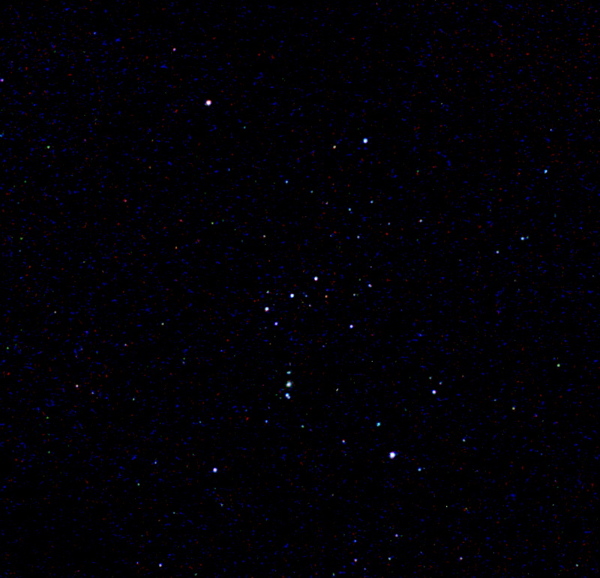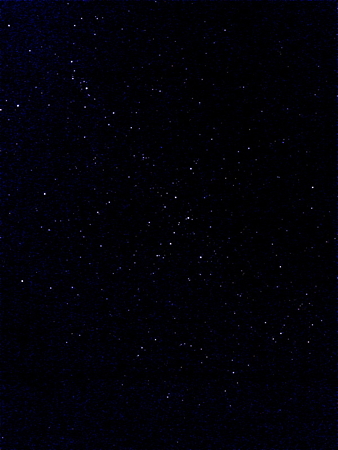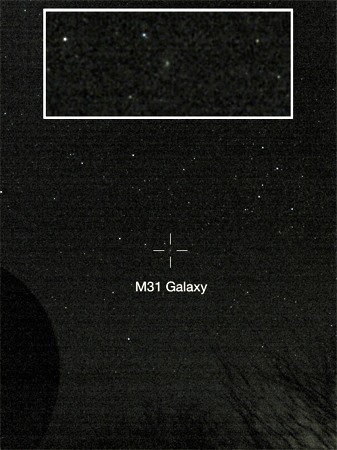Review - NightCap Pro v6 App
for iPhone Astrophotography
Posted: 18 April 2015
Astrophotography
For most of my NCP astrophotography I used Long exposure and Light boost, with no Noise reduction. All of the images were saved in NCP using the "HQ JPEG" setting. Image editing was done mostly in Apple Aperture software, with some final editing in GraphicConverter.
NightCap Pro is ideally suited to nighttime sky photography, as seen in these photos I took, with exposure settings noted (when available).
Milky Way, GorillaPod mounted (Long exposure, Light boost, 1/2sec, ISO 2000, 30 second exposure):

Perseus and Pleiades, GorillaPod mounted (Long exposure, Light boost, 1/2sec, ISO 2000, 1 minute exposure):

Zodiacal Light, piggyback on telescope (Long exposure, Light boost, 1/2sec, ISO 2000, 5 minute exposure):

Orion, piggyback on telescope (Light trails, Light boost, 1/2sec, ISO 2000, 10 minute exposure):

Cassiopeia, piggyback on telescope (Long exposure, Light boost, 1/2sec, ISO 2000, 5 minute exposure):

M31 Andromeda Galaxy (see inset), piggyback on telescope (Long exposure, Light boost, 1/2sec, ISO 2000, 5 minute exposure):

Orion, Canis Major, star Canopus, handheld (Long exposure, Light boost, 1/2sec, ISO 8000):

Star Trails, GorillaPod mounted (Light trails, Light boost, 1/2sec, ISO 8000, 1 hour exposure):

The Light trails image above was fascinating to acquire. During the one hour exposure I watched the star trails lengthen on the screen, the airplane trails grow longer (horizontal streaks), and three very faint polar orbiting satellites appear (vertical streaks). The bright non-trailed spots may be tumbling satellites or head-on meteors that NCP captured.
Afocal astrophotography with the iPhone through my 8" LX200-ACF telescope is another area where NightCap Pro really shows what it can do. Here are some examples I have done:
M57 Ring Nebula, 77X (Long exposure, Light boost, 1/2sec, ISO 2000, 2 minute exposure):

Double Cluster, 48X (Long exposure, Light boost, 1/2sec, ISO 2000, 1 minute exposure):

M13 Globular Cluster, 77X (Long exposure, Light boost, 1/2sec, ISO 2000, 1 minute exposure):

M27 Dumbbell Nebula, 77X (Long exposure, Light boost, 1/2sec, ISO 2000, 1 minute exposure):

M11 Wild Duck Star Cluster, 77X (Long exposure, Light boost, 1/2sec, ISO 2000, 1 minute exposure):

Comet Lovejoy, 48X (Long exposure, Light boost, 1/2sec, ISO 2000, 5 minute exposure):

M42 Orion Nebula, 77X (Long exposure, Light boost, 1/2sec, ISO 2000/4000/8000, stack of 3 2 minute exposures):

M45 Pleiades, 48X (Long exposure, Light boost, 1/2sec, ISO 4000, stack of 5 2 minute exposures):

NGC2024 Flame Nebula, 48X (Long exposure, Light boost, 1/2sec, ISO 4000, stack of 5 2 minute exposures):

M1 Crab Nebula, 48X (Long exposure, Light boost, 1/2sec, ISO 4000, stack of 5 2 minute exposures):

M51 Whirlpool Galaxy, 77X (Long exposure, Light boost, 1/2sec, ISO 8000, 2 minute exposure):

Obviously the brighter the Deep Sky Object (DSO) the better the resulting image will be. But for a smartphone camera to be able to capture faint DSOs like the Flame Nebula, the Crab Nebula, and the Whirlpool Galaxy, is absolutely mindblowing. As seen from the Orion Nebula image, stacking multiple images can be of benefit. Even "dark frame subtraction" to remove digital noise (something I have not yet tried) will likely improve images. I plan to do more NCP DSO imaging in the future, especially of fainter DSOs.
Which exposure mode you use for long duration astrophotography will depend on the object and the type of mounting you use. For most typical telescope astrophotography you will use "Long exposure" with "Light boost". Keep in mind that the in-app processed image will almost always look better than the live image you see on the screen.
This review has shown just a sample of iPhone NightCap Pro astrophotography. I definitely look forward to using NightCap Pro for more iPhone astrophotography.
Summary
NightCap Pro was not conceived as an app for astrophotography, but its features meant that it could be used for some types of imaging of the night sky. Version 6 expands on those features, making it an even more useful app for astrophotography. As you can see from the few examples in this review, astrophotography of stars, the Milky Way, brighter Deep Sky Objects (DSOs), and even the faint Zodiacal Light and some faint DSOs, is possible with an iPhone when using NightCap Pro v6. Of course, it remains an incredible app for any types of low-light photography.
If the iPhone is your only camera and you want to take photographs of the night sky, you need NightCap Pro. If you have a telescope and the iPhone is your only camera, NightCap Pro v6 should definitely be your app of choice for telescopic imaging. If the iPhone is not your only camera, you will still find NightCap Pro an incredibly useful app to have for those situations where your other camera (or a dedicated astro-imager) is not available. And you'll be able to impress your friends with just what Apple's iPhone camera can photograph.
Go back to Page 1 of "Review - NightCap Pro v6 App for iPhone Astrophotography".
Go to Page 3 to read what's new in version 7.
Cassiopeia Observatory Home Page
Copyright ©2015 Michael L. Weasner / mweasner@me.com
URL = http://www.weasner.com/co/Reviews/2015/NCP_v6/index2.html
